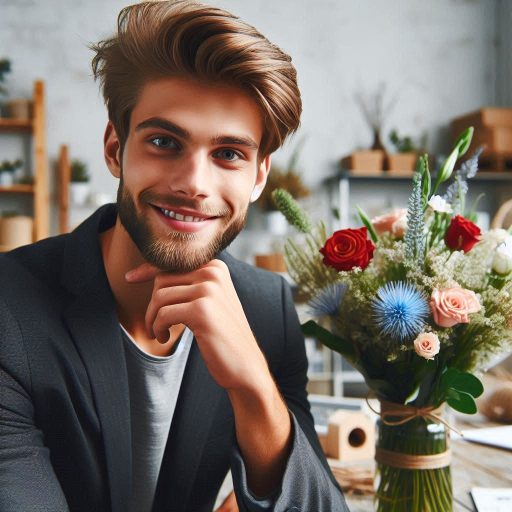Introduction
The daily life of a professional floral designer revolves around creativity, precision, and a deep passion for nature.
Floral designers play an essential role in various industries, including weddings, events, and retail.
They transform simple flowers into captivating arrangements that enhance the atmosphere and emotion of any space.
Floral designers bring beauty to every occasion, crafting arrangements that reflect the personality and desires of their clients.
In this blog post, we will explore the day-to-day responsibilities of a professional floral designer.
From early morning trips to flower markets to working in studios or storefronts, we will delve into the tasks that make up their routine.
Additionally, we will discuss the creative processes involved in designing unique arrangements, as well as the challenges they face in meeting deadlines and client expectations.
We‘ll also highlight how floral designers keep up with trends and maintain their expertise through continuous learning.
By the end of this blog, you‘ll gain a deeper understanding of the dedication, artistry, and business acumen that go into the daily life of a floral designer.
Job Responsibilities
Typical tasks and responsibilities of a professional floral designer
A professional floral designer has a variety of responsibilities that require creativity and precision.
Designing floral arrangements for different occasions, such as weddings, funerals, or corporate events, is a key task.
Each design must match the event‘s theme while maintaining a balance of colors, textures, and shapes.
Floral designers work closely with clients to understand their preferences and requirements.
This ensures that the final arrangement exceeds their expectations.
The creative aspect of the job
Importance of attention to detail and creativity in floral design
The creative aspect of the job is one of the most rewarding parts for floral designers.
They combine various flowers, greenery, and accessories to create unique and captivating designs.
Floral designers often follow trends, but they also innovate to offer something fresh and personalized.
They also need to consider the symbolism of flowers when crafting meaningful arrangements.
Attention to detail is crucial in floral design.
Each flower must be carefully selected for its condition, size, and color to maintain consistency in the arrangement.
Transform Your Career Today
Unlock a personalized career strategy that drives real results. Get tailored advice and a roadmap designed just for you.
Start NowDesigners must also consider the lifespan of flowers to ensure they remain fresh for the event.
Creativity is equally important. Floral designers need to think outside the box to bring their clients’ visions to life.
They must develop new ideas regularly to stay competitive. In addition, they need to balance beauty with practicality, considering factors like transportation and display.
In summary, a professional floral designer combines creativity, precision, and attention to detail in their daily work.
They create stunning floral arrangements that elevate events and bring joy to their clients.
Read: How to Collaborate with Developers as a Web Designer
Daily Schedule
A typical day in the life of a floral designer
As a professional floral designer, each day is filled with creativity, passion, and hard work.
Here is a glimpse into a typical day in the life of a floral designer:
Early Mornings
- Preparation: Floral designers start their day early to ensure they have enough time to prepare for upcoming orders and events.
- Order Processing: The morning is dedicated to processing orders, checking inventory, and planning the day’s floral arrangements.
- Design Inspiration: Many designers find inspiration in the early morning hours, whether it’s from nature, art, or current trends.
- Creating Bouquets: The early morning hours are often spent creating beautiful bouquets and arrangements for daily orders or events.
Late Nights
- Event Setup: Late nights are common in the floral industry, especially when designers are setting up for events like weddings or corporate functions.
- Last-Minute Orders: Designers may receive last-minute orders that require late-night work to ensure they are ready for delivery the next day.
- Cleaning Up: After a long day of designing and creating, designers will often spend late nights cleaning up their workspace and organizing materials.
- Reflecting: Late nights provide a quiet moment for designers to reflect on the day’s work, assess their designs, and plan for the next day.
Importance of Time Management
- Meeting Deadlines: Time management is crucial for floral designers to meet deadlines for events, orders, and deliveries.
- Client Expectations: Clients expect their floral arrangements to be ready on time, making effective time management essential in the industry.
- Work-Life Balance: Managing time effectively allows designers to maintain a healthy work-life balance and avoid burnout.
- Creativity: Contrary to popular belief, time management actually enhances creativity by allowing designers to focus their energy and efforts efficiently.
In fact, the daily life of a professional floral designer is a perfect mix of creativity, hard work, and time management.
By starting early, working late, and managing their time effectively, floral designers are able to create stunning arrangements and exceed client expectations.
Read: The Art of Minimalist Web Design
Workspace
As a professional floral designer, having a well-organized workspace is crucial for efficiency and creativity.
Working Environment
The working environment of a floral designer typically involves a mix of creative chaos and meticulous organization.
There are various elements that contribute to the overall workspace:
- Large work tables: Floral designers often work on large, sturdy tables to arrange flowers and create their designs.
- Storage shelves: These are essential for keeping an inventory of different types of flowers, foliage, vases, and other supplies organized and easily accessible.
- Tool organization: Tools such as floral shears, wire cutters, and tape should be stored in a designated area for quick access during design work.
- Design area: A designated space where the designer can step back and assess their work from different angles is crucial for the creative process.
- Natural light: Having access to natural light is ideal for evaluating the true colors and textures of the flowers being used in a design.
Tools and Equipment
Floral designers rely on a variety of tools and equipment to create their stunning arrangements.
Some common tools include:
- Floral shears: High-quality shears are essential for cutting stems and shaping flowers with precision.
- Wire cutters: Used for cutting floral wire and creating support structures for arrangements.
- Pruning knife: A sharp knife is needed for more intricate cuts and shaping of foliage.
- Floral tape: This is used to secure stems together and create a more polished look for arrangements.
- Design trays: These shallow trays help designers organize and transport smaller floral accents for their arrangements.
Importance of a Well-Organized Workspace
A well-organized workspace is essential for a professional floral designer for several reasons:
- Efficiency: Knowing where everything is located can save time and prevent unnecessary searching for supplies.
- Inspiration: A clean and organized workspace can help spark creativity and allow designers to focus on their craft.
- Safety: Proper organization can prevent accidents, such as misplaced sharp tools, which can lead to injuries.
- Client Impressions: A well-organized workspace reflects professionalism and attention to detail, which can enhance a client’s impression of the designer.
- Workflow: An organized workspace can improve workflow and ensure that projects are completed on time and within budget.
Overall, maintaining a well-organized workspace is crucial for the success of a professional floral designer.
It not only enhances efficiency and creativity but also helps create a safe and inviting environment for both the designer and their clients.
Showcase Your Business Today
Reach thousands of readers actively exploring professional services. Publish your business profile and grow your audience now.
Publish NowRead: Web Design Case Studies: Learning from the Best

Collaboration
Collaboration is a crucial aspect of a professional floral designer’s daily life.
Let’s delve into how floral designers often collaborate with various professionals and the importance of effective communication and teamwork in the industry.
Collaboration with Event Planners, Clients, and Other Professionals
Floral designers frequently work hand in hand with event planners to create cohesive and visually appealing decor for various events.
They collaborate with clients to understand their vision and preferences, ensuring the floral arrangements align with their expectations.
Collaboration with other professionals such as photographers, caterers, and venue coordinators is essential for seamless event execution.
Importance of Communication and Teamwork
Effective communication is key to successful collaborations in the floral design industry.
Clear communication ensures everyone is on the same page.
Teamwork among floral designers, event planners, and other professionals is crucial for creating a cohesive and harmonious event atmosphere.
By working collaboratively, professionals can leverage each other’s skills and expertise to deliver exceptional results for clients.
Understanding Clients’ Vision and Preferences
One of the most critical aspects of collaboration is understanding the vision and preferences of clients.
Floral designers must listen carefully to clients’ ideas.
By grasping the clients’ vision, floral designers can tailor their design concepts to meet and exceed expectations, resulting in satisfied clients.
Through effective collaboration and understanding clients’ preferences, floral designers can create memorable and personalized floral arrangements for each event.
In short, collaboration plays a vital role in a professional floral designer’s daily routine.
By working closely with event planners, clients, and other professionals, and emphasizing communication, teamwork, and understanding clients’ visions, floral designers can create stunning floral arrangements that leave a lasting impression.
Read: The Impact of AI on the Web Design Industry
Trends and Inspiration
How floral designers stay up-to-date on the latest trends in floral design
Keeping up with the latest trends in floral design is crucial for professional floral designers to stay relevant in the industry.
Here are some ways floral designers stay up-to-date:
- Attending floral design workshops and classes: This allows designers to learn new techniques and trends from industry experts.
- Following floral design publications and blogs: Publications like Florists’ Review and blogs like Flowerona provide valuable insights into current trends.
- Networking with other floral designers: By connecting with peers in the industry, designers can share ideas and inspire each other.
- Participating in floral design competitions: Competitions challenge designers to think outside the box and push their creativity to new levels.
Sources of inspiration for floral arrangements
When it comes to finding inspiration for floral arrangements, the possibilities are endless.
Here are some common sources of inspiration for floral designers:
- Nature: The colors, shapes, and textures found in nature often serve as a rich source of inspiration for floral designs.
- Art and design: Paintings, sculptures, and other forms of art can spark ideas for unique floral arrangements.
- Travel: Experiencing different cultures and landscapes while traveling can inspire new design concepts and color palettes.
- Fashion: Trends in the fashion industry often influence floral design, with designers drawing inspiration from runway looks and textiles.
Importance of creativity and innovation in creating unique designs
Creativity and innovation are essential qualities for professional floral designers looking to create unique and memorable designs.
Here’s why:
- Standing out from the competition: In a saturated market, innovative designs help designers differentiate themselves and attract clients.
- Meeting client expectations: Clients often seek out floral designers who can offer fresh and original ideas for their events and occasions.
- Showcasing skill and talent: Creativity allows designers to showcase their talent and expertise in the art of floral design.
Challenges
Challenges that floral designers may face in their daily work
One of the biggest challenges that floral designers may face in their daily work is meeting tight deadlines.
With clients expecting their arrangements to be ready by a specific date and time, it can be stressful to ensure everything is completed on schedule.
Another challenge is dealing with demanding clients who have specific preferences and expectations.
Some clients may have a vision in mind for their event or occasion, and it’s up to the floral designer to bring that vision to life while also adding their own creative touch.
Budget constraints can also pose a challenge for floral designers, as they must work within the client’s budget while still delivering a high-quality product.
This can mean having to make tough decisions about which flowers and materials to use, as well as finding cost-effective ways to create stunning arrangements.
Strategies for overcoming challenges and staying motivated
To overcome these challenges and stay motivated, floral designers can implement a few strategies:
- Prioritize tasks and create a schedule to ensure deadlines are met.
By breaking down projects into manageable steps, floral designers can stay organized and on track. - Communication is key when dealing with demanding clients.
Listen closely to their needs and preferences, and provide updates throughout the design process to ensure they are happy with the final result. - Get creative with budget constraints by exploring different flower options, incorporating greenery and filler flowers, and reusing materials when possible.
This can help stretch the budget while still creating beautiful arrangements. - Take breaks and practice self-care to avoid burnout.
Floral design can be a physically and mentally demanding job, so it’s important to take time to recharge and rejuvenate. - Seek inspiration from other designers, nature, and art to stay motivated and refresh creativity.
Attend workshops, trade shows, and networking events to learn new techniques and stay up-to-date on industry trends.
By staying organized, communicating effectively with clients, getting creative with budget constraints, practicing self-care, and seeking inspiration, floral designers can overcome challenges and thrive in their daily work.
You Might Also Like: The Impact of Technology on Production Design
Training and Education
When it comes to becoming a professional floral designer, there are a few key aspects to consider in terms of training and education.
Here’s a breakdown of what it takes to enter this creative and dynamic field:
Formal Training
Many aspiring floral designers start by completing a formal education program in floral design or a related field.
These programs are offered at community colleges, vocational schools, and some universities.
Formal training provides students with a solid foundation in the principles of design, flower care, and industry best practices.
Hands-On Experience
Working in a floral shop or assisting a professional designer is a valuable way to gain hands-on experience.
This practical experience allows aspiring designers to learn about flower varieties, design techniques, and customer interaction.
Hands-on experience is crucial for developing the skills and confidence needed to succeed in the industry.
Showcase Your Business Today
Reach thousands of readers actively exploring professional services. Publish your business profile and grow your audience now.
Publish NowContinuous Learning
Floral design is a constantly evolving field, so it’s important for designers to stay current with trends and techniques.
Continuous learning can involve attending workshops, seminars, and industry events to expand knowledge and skills.
Keeping up to date with the latest trends and innovations ensures that designers can offer their clients the best and most creative designs.
Certifications
Obtaining certifications in floral design can enhance a designer’s credibility and open up new opportunities for career advancement.
Professional certifications, such as those offered by industry organizations, demonstrate a commitment to excellence and continued learning.
Having a certification can also help designers stand out in a competitive job market and attract more clients.
Workshops and Seminars
Attending specialized workshops and seminars can provide designers with in-depth knowledge on specific areas of floral design.
These events offer the chance to learn from experts in the field, network with other professionals, and gain inspiration.
Participating in workshops and seminars can spark creativity and help designers refine their skills.
In a nutshell, the training and education required to become a professional floral designer are multifaceted.
Formal education, hands-on experience, continuous learning, certifications, and attending workshops and seminars all play a crucial role in shaping a successful career in the floral design industry.
Conclusion
The daily life of a professional floral designer is filled with creativity, passion, and hard work.
Each day involves creating stunning floral arrangements, sourcing the freshest flowers, and working with clients to bring their vision to life.
The dedication and attention to detail required to succeed in this field are truly admirable.
From early mornings at the flower market to late nights preparing for events, floral designers pour their heart and soul into their work to create beautiful masterpieces that bring joy to others.
As readers, it’s important to appreciate the artistry and dedication of floral designers in their daily work.
They play a crucial role in adding beauty and elegance to weddings, special events, and everyday life.
Next time you see a stunning floral arrangement, take a moment to admire the talent and hard work that went into creating it.
Ultimately, being a professional floral designer is not just a job, but a passion.
It requires a unique blend of artistic skill, attention to detail, and a love for nature.
So, let’s continue to support and celebrate the creativity and dedication of floral designers in their craft.
[E-Books for Sale]
The Big Book of 500 High-Paying Jobs in America: Unlock Your Earning Potential
$19.99 • 500 High-Paying Jobs • 330 pages
Explore 500 high-paying jobs in America and learn how to boost your career, earn more, and achieve success!
See All 500 High-Paying Jobs of this E-Book
1001 Professions Without a Degree: High-Paying American Jobs You Can Start Now
$19.99 • 1001 Professions Without a Degree • 174 pages
Discover 1001 high-paying jobs without a degree! Unlock career tips, skills, and success strategies for just $19.99!




